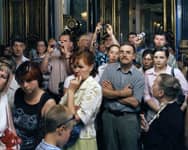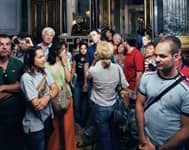An approach by Franca Falletti, Director of the Galleria dell’Accademia in Florence to participate in a homage to mark the 500th anniversary of Michelangelo’s David gave Struth the opportunity to revisit this project. Analysing the spatial dynamics of the room in which David stands confirmed that by positioning the camera beneath the sculpture, Struth could indeed show the audience’s gaze from the perspective of the work of art.
Over the course of one week in 2004, Struth worked in the David room at the Accademia. Using an 8 x 10 format and for the first time a system of artificial flash light, Struth was able to shorten the exposure and illuminate the audience from a position adjacent to the sculpture whilst diminishing the presence of the paintings behind the viewers.
The spatial installation represents a further development of Struth’s interest in an immersive viewing experience. As in the Paradise photographs, the viewing experience is decentred, and there is no hierarchy between the different elements in the picture. “They deal with peripheral vision, what happens between awareness and actual seeing. Indeed, this is ultimately the main subject matter of the audience photograph, to see a variety of emotional and intellectual responses shared by a heterogeneous community, which exists just in the moment of the picture.”
Struth continued this project with a second series of works, based on close-ups of people looking at a single work, Leonardo da Vinci’s Madonna with a Flower (Benois Madonna) in the State Hermitage Museum in St. Petersburg in 2005. The viewers themselves again become the focus, whilst the object of their attention, the da Vinci painting, is not visible.













